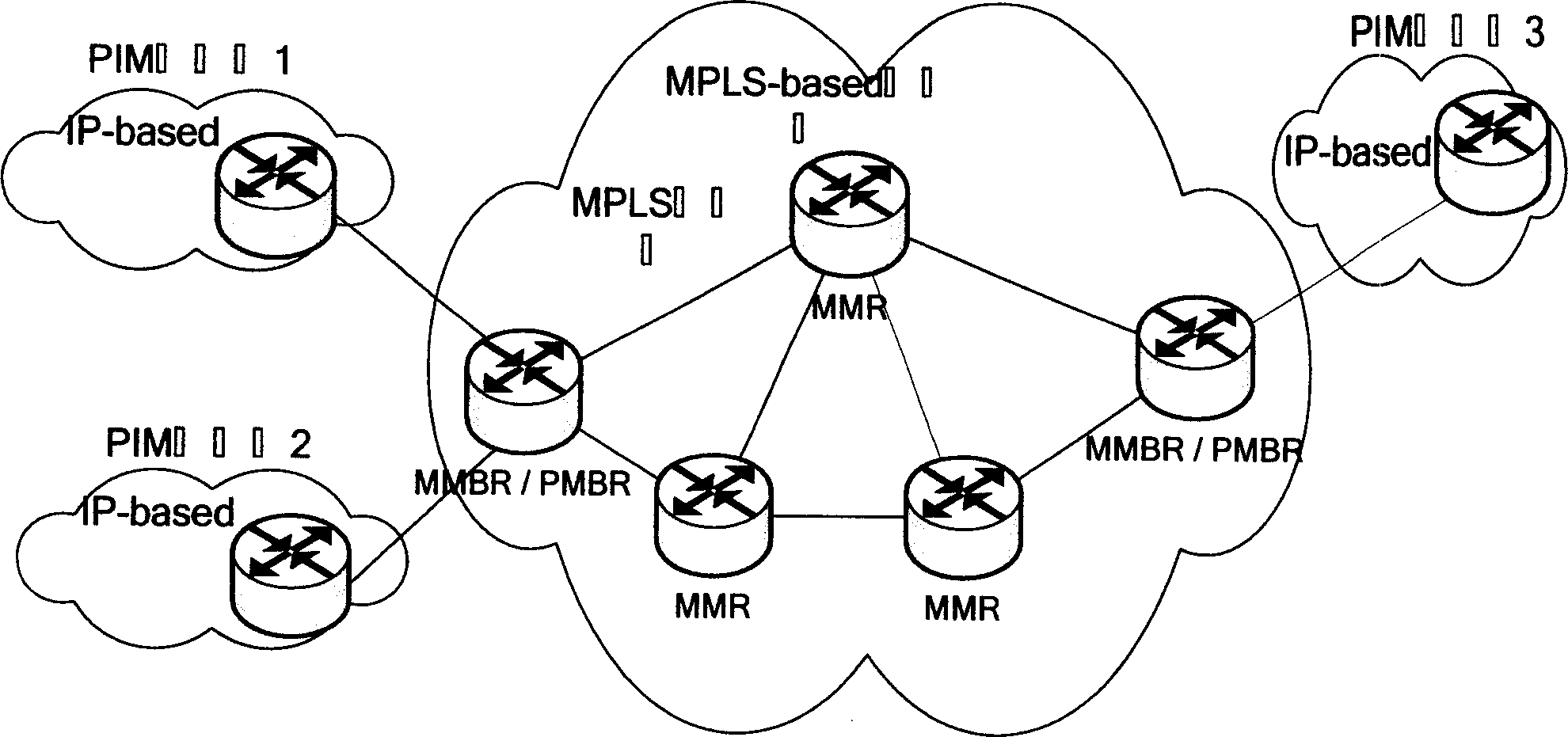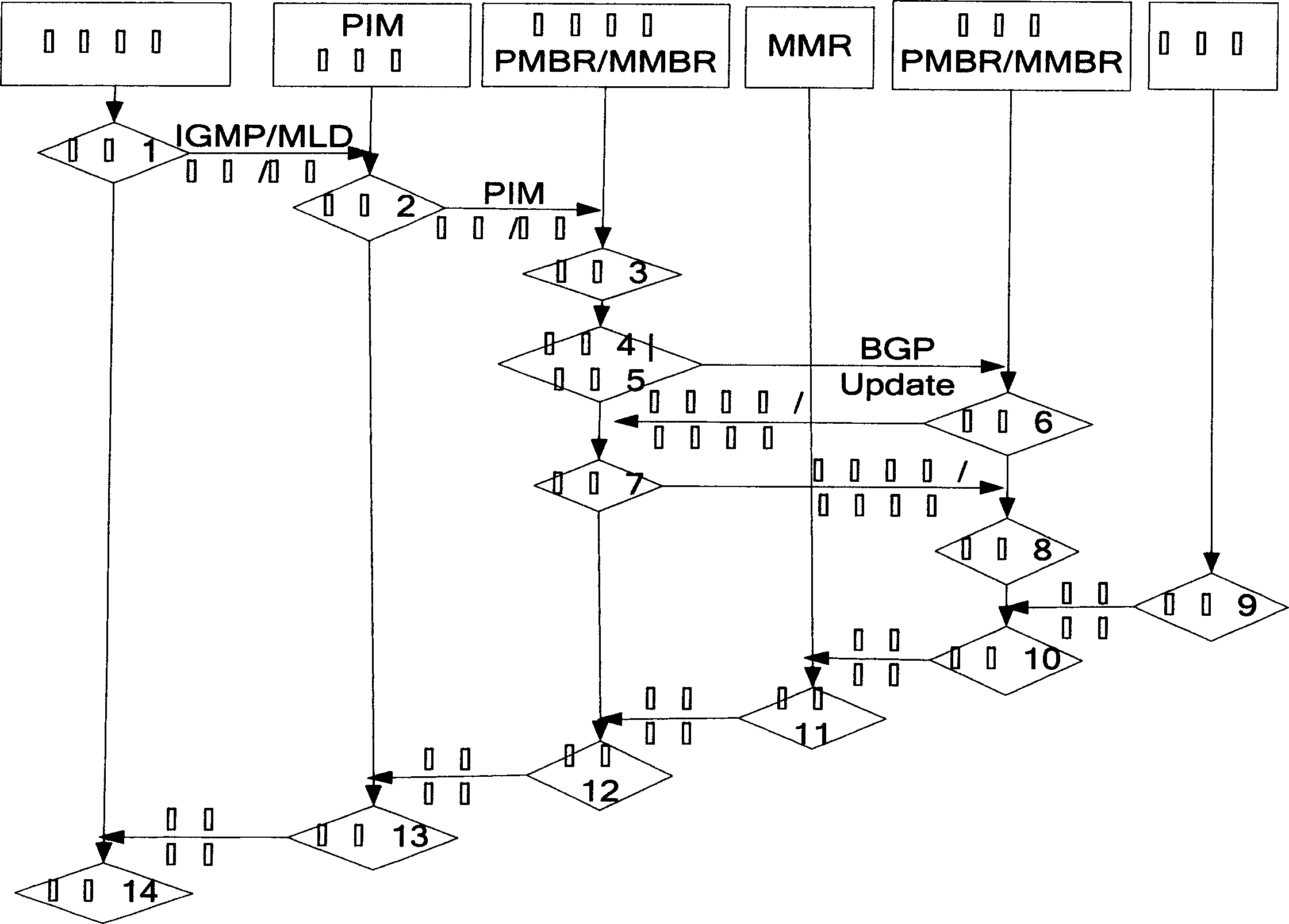Multi-domain multicast integration data distributing structure and method based on IP/MPLS/BGP
A data distribution and multicast data technology, applied in the field of computer networks, can solve problems such as limited development, limited multicast function support, insufficient address space, etc., and achieve the effect of promoting use
- Summary
- Abstract
- Description
- Claims
- Application Information
AI Technical Summary
Problems solved by technology
Method used
Image
Examples
Embodiment 1
[0067] Embodiment 1: a multi-domain multicast integrated data distribution structure based on IP / MPLS / BGP,
[0068] figure 1 It is a schematic diagram of the network topology. The network includes an MPLS core multicast domain and three different IP-based PIM multicast domains.
[0069] exist figure 1 In , all IP-based PIM multicast domains are connected to the MPLS core multicast domain by using a PIM Multicast Border Router (PMBR, PIM Multicast Border Router). At the same time, the PMBR is also an edge router of the MPLS core multicast domain. From the perspective of the MPLS core multicast domain, the PMBR can be called an MPLS Multicast Border Router (MMBR, MPLS Multicast Border Router).
[0070] In the scheme, the PMBR of each PIM multicast domain also serves as the RP of the multicast domain. If the user wants to configure an additional RP in the PIM multicast domain, the anycast-RP and MSDP mechanisms must be used in the PIM multicast domain to ensure that the PMBR a...
Embodiment 2
[0078] A multi-domain multicast integrated data distribution method based on IP / MPLS / BGP, comprising the following steps;
[0079] Step 1: Multicast route establishment process in the network;
[0080] To transmit multicast data in the network, the correct multicast routing information must be established first. The establishment process of multicast routing information in the network is listed below:
[0081] Step 1: There are terminal multicast users in the edge IP-based PIM multicast domain using IGMP or MLD protocol to join or exit a multicast group;
[0082] Step 2: The PIM multicast routing protocol will generate a PIM multicast routing table according to the multicast user joining or leaving information; the PIM join / prune message triggered by the end user in the edge IP-based PIM multicast domain will reach the PMBR / MMBR;
[0083] Step 3: PMBR / MMBR updates the current multicast routing information in the multicast edge routing table MBRF;
[0084] Step 4: When a mult...
Embodiment 3
[0123] A multi-domain multicast architecture based on IP / MPLS / BGP such as image 3 As shown, the establishment process of network multicast routing information in this architecture is completed in the following steps:
[0124] Step 1: Multicast user 1 wants to join a multicast group, it first sends an IGMP / MLD join message to the DR (Designate Router, Designated Router) of multicast user 1.
[0125] Step 2: After the DR of multicast user 1 receives the IGMP / MLD message, it is processed by the PIM protocol, and a (*, multicast group address) routing item is established in the multicast routing table; the DR on the multicast user 1 The PIM protocol generates a PIM join message, which is sent to the PMBR / MMBR of multicast user 1 hop by hop.
[0126] Step 3: After receiving the PIM join message, the PMBR / MMBR of the multicast user 1 performs a hash operation on the address of the multicast group that the multicast user joins this time. The PMBR / MMBR of multicast user 1 creates a...
PUM
 Login to View More
Login to View More Abstract
Description
Claims
Application Information
 Login to View More
Login to View More - R&D
- Intellectual Property
- Life Sciences
- Materials
- Tech Scout
- Unparalleled Data Quality
- Higher Quality Content
- 60% Fewer Hallucinations
Browse by: Latest US Patents, China's latest patents, Technical Efficacy Thesaurus, Application Domain, Technology Topic, Popular Technical Reports.
© 2025 PatSnap. All rights reserved.Legal|Privacy policy|Modern Slavery Act Transparency Statement|Sitemap|About US| Contact US: help@patsnap.com



